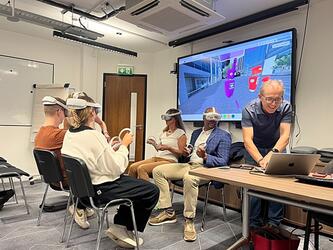No shortage of hype: Lessons from the MRS metaverse conference

Impact on qual
The metaverse is most often spoken about in connection with qualitative work, where its more interactive nature could help focus groups and other qualitative techniques adapt to a more online world.
Faye Soares, customer intelligence manager at Dow Jones, said a pilot programme of metaverse research carried out with research firm Kadence International was positive, with virtual reality (VR) giving a “realistic impression of being in a room together” and “felt like a traditional focus group”.
She added that the use of avatars in the technology “gave a real sense of who these people were as individuals” and that she was surprised at the level of rapport between the research participants and felt more connected than in traditional online focus groups.
Rupert Sinclair, head of insight, UK at Kadence International, said that there were some drawbacks, one being the difficulty of using the VR headsets and platforms. People needed to get used to the devices and the pilot helped road test a few formats, including co-creation work, website navigation and group discussions.
The biggest negative, however, was people’s access to the headsets needed for VR research. “Relatively few people own the devices currently,” Sinclair said. “People who have them are very heavily skewed towards early adopters, who are probably not representative of the wider population.”
There were also privacy, security and safeguarding questions, and potential issues from cross-cultural communications, as people around the world gathered in one virtual space. “It seems quite possible there will be misunderstandings and challenges when you are bringing people together into a quite intimate space,” Sinclair added. “Setting boundaries or expectations at the start would be a good idea.”
Managing the hype
In a panel session, Alexandra Kuzmina, innovation consultant at Nova MMR, said that users needed to realise the metaverse was in its infancy, and compared it to the early days of space research.
“There has been no shortage of hype,” said Kuzmina. “It is important to remind ourselves that what we see currently are only the fragments of what eventually will become the metaverse. There is a tendency today to believe the fragments, such as VR and augmented reality (AR), are actually the metaverse. I wouldn’t bet against the metaverse dream just yet.”
She added that AR could have a positive impact on quantitative work, based on her own experiments. “AR helps us increase engagement; people gave us twice as many words in the open answers and those words were more thematically meaningful.”
However, the fact it took 1,300 people to get to 100 completes, mainly because people were cautious about the AR technology used, meant that quant surveys in the metaverse were still a while away. “It is still relatively new to most, and perhaps it is not that viable currently for quant research,” said Kuzmina. “But as the technology develops and adoption rates increase, it will be easier to implement with less impact on completion rates.”
Valerie Bounds, chief strategy and creative officer at Aurora Agency, said the interactive environment in the metaverse was a big positive. “You couldn’t get that level of research from a traditional filling out a form or from a focus group,” she said. “It gives brands a whole different level of understanding their audience.”
Barriers to adoption for brands
In a second panel session, David Evans, senior director, global partnerships, at NBCUniversal, said awareness of the metaverse was high but fewer people had engaged with the technology.
“What could be stronger was around familiarity, and a lack of familiarity of what proposition the metaverse offers to people, what are the strong benefits and use cases where the metaverse can enhance and enable different elements of people’s lives,” explained Evans.
“There is a real opportunity for brands where they can reassure customers and consumers that the metaverse is a safe space on a number of different levels, from data privacy and security to personal safety.”
Daniel Hardwick, associate director at 2CV, said that there was a high level of confusion about what the metaverse could do to help consumers.
“The lack of a unified definition of what is the metaverse is creating barriers for people,” he said. “The multitude of brands trying to enter the metaverse is creating more confusion for people, as people put the label ‘metaverse’ on things. It is creating a consumer lack of familiarity and makes it harder to understand what it is they are taking part in.”
Hereward Feldwick, qualitative research director at Basis Research, added there were significant issues with the metaverse platforms that currently existed, but that the industry needed to ensure these issues were ironed out and the benefits of greater interaction promoted to successfully attract users.
Feldwick explained: “People we spoke to did have stories of harassment and abuse, and had concerns around privacy and trust – how do I know the person I am speaking to is who they say they are? It is not clear either whose responsibility it is to police them.
“What is important to bear in mind is a barrier needs to be considered in relation to a benefit. If the benefits are great enough, the barriers become less obstructive and there becomes more reason to get past it. Once the benefits become clearer, become more resonant and meaningful, and as the platforms mature and more people move into virtual spaces, those benefits will become more obvious and we will find ways to overcome those barriers.”

We hope you enjoyed this article.
Research Live is published by MRS.
The Market Research Society (MRS) exists to promote and protect the research sector, showcasing how research delivers impact for businesses and government.
Members of MRS enjoy many benefits including tailoured policy guidance, discounts on training and conferences, and access to member-only content.
For example, there's an archive of winning case studies from over a decade of MRS Awards.
Find out more about the benefits of joining MRS here.














0 Comments